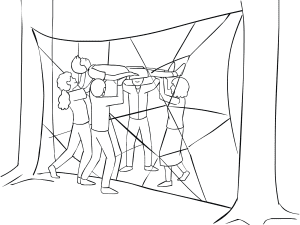One of the most powerful frameworks I encountered when I was first learning adventure programming was “site versus central.”
At first glance, this may not mean anything to you. But, you may know of this particular framing in the context of “Us v Them” or “Workers v Management.” These labels may give you a closer inkling of what ‘Site v Central’ is all about.
But first, let’s look at some of the most common forms of group initiative presentation or framework.
Three Common Ways to Frame an Activity
Group initiatives work well when sequenced and presented in a manner that makes sense to your group. While there is no shortage of ways to achieve this important objective, I like to categorise them into one of three groups:
-
Tell It Like It Is
This involves simply describing the practical nature of the task, without any fanciful language or phoof (which is a technical term for unnecessary activity.) For example, if you are presenting the Nitro Crossing, you would simply ask your group to work together to find a way to move everyone from one side of the exercise (Point A) to the other (Point B,) perhaps identifying specific areas by a line drawn on the ground, two ropes, obstacles, etc.
-
Story-Telling Fancy
This presentation mode explains all of the above but in a way that weaves in a fanciful story to inspire the group’s creativity and energy. Following on from the example above, you may describe the no-go area that sits between Point A and Point B as a ‘peanut butter pit’ and the reason why the group must move quickly is because a group of rampaging pygmy possums is chasing them.
-
Metaphor
The introduction of a metaphor can help your group to connect what they are doing in the activity to their real worlds. That is, the metaphoric parallels of the activity to the real world of the group can make their experience far more meaningful, especially when it comes time to reflect on the experience. For example, there are strong parallels between the effort required of a group to traverse between Points A and B in the Nitro Crossing and the collaboration required of the team to complete their next big project successfully, eg clear communication, collaborative effort, aligned values, etc.
One way is not necessarily better than the other. The key is variety, but I will say that the more you can do as a group facilitator to model the real-world environment of your group mirror or reflect the problem-solving activity you are about to present, the more valuable your group experience will be.
The Site v Central Set-Up
The basic Site v Central concept is a variation of a metaphoric framing.
That is, you present the exercise in a way that helps your group easily imagine and transfer their experience with the activity to their day-to-day workplace interactions.
One of the most common group dynamics, regardless of the setting, is that one group often has less power than another. Think of the relationships between workers on an assembly line and their production managers. Or, clerical workers and their boss. Teachers and their principals. You get the idea.
The key to setting up a site/central adventure experience is to frame it as such from the beginning. The more you can do to replicate or reflect the actual interactions and workplace settings of these two groups, the more likely each group will be able to imagine the parallels between what they are experiencing (in the game) and reality.
I think a quick example will suffice.
An Illustration: Spider’s Web
 Before presenting or even showing the Spider’s Web, you split your group into two smaller teams – workers (site) and management (central.) Most often the management team is smaller, but it doesn’t have to be. Each group is aware of its specific role (and label) in the activity.
Before presenting or even showing the Spider’s Web, you split your group into two smaller teams – workers (site) and management (central.) Most often the management team is smaller, but it doesn’t have to be. Each group is aware of its specific role (and label) in the activity.
You invite the managers to stay put, and then lead the rest of your group (the workers) to gather in front of the Spider’s Web. In addition to your typical briefing of this fun group problem-solving activity, you tell the workers that they are not permitted to complete any part of the exercise without the express approval of their managers.
Ordinarily, this will look like one or more of the workers walking over to the (off-site) managers to speak with them. Even better, if these two groups in reality never meet but instead use the telephone (or Zoom) to communicate, then introduce this medium as part of your set-up.
Keep in mind, the managers cannot see the Spider’s Web (nor are they ever allowed to,) which is not too far removed from the reality of most management level personnel, ie see the metaphor.
As you can imagine, the activity will take on many varied paths forward.
Some site workers will accept their fate, and (reluctantly) seek permission from central HQ for everything they do. Others will upset their managers because they choose to subvert their authority and act alone. Meanwhile, some managers over-analyse everything and never allow the workers to do what they are good at, etc.
You can just imagine how all of these interactions may mirror the real-world experiences of your group.
Which is the whole point of the Site v Central framework.
What Activities Can ‘Site v Central’ Apply To?
There are countless ways in which this framing can be applied to a group experience. But, it is especially useful if the activity is focused on a problem-solving experience. Think of any team-building games and activities and I expect there will be a simple way to adapt the exercise.
In the simplest form, it’s a brilliant way to embrace a metaphor in your framing.
Describe in the Comments below some other ways you have developed a metaphor in your team-building exercises.
Or, if you need help developing a useful metaphor for your particular setting or program, reach out to me by clicking the link below.
Build a Metaphor with Mark













Original post February 2023, last updated February 2023.